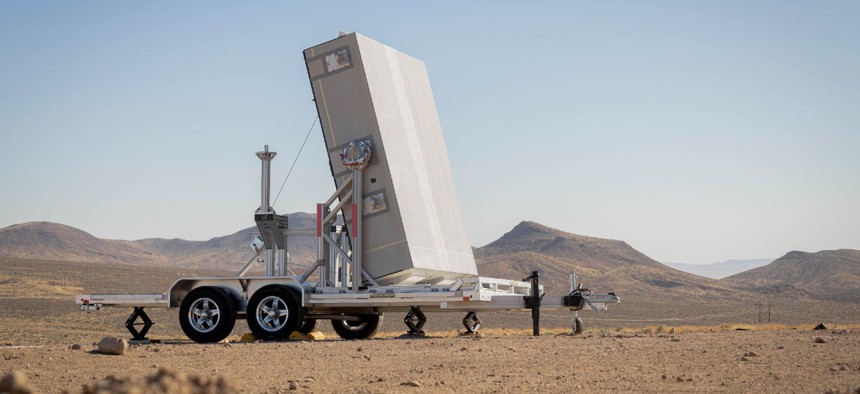Counter-drone Startup Successfully Links Capability with Key Army C2 Software

A prototype of the Leonidas system. Courtesy of Epirus
The software-defined high-power microwave solution created by Epirus is also compatible with anything else that integrates with the C2 software.
Epirus, a startup developing directed energy systems, in a new field test successfully integrated its counter-drone solution with a key Defense Department command and control system.
In its latest company field test, the Epirus counter-unmanned aerial systems capability, called Leonidas, successfully integrated with the Army’s Forward Area Air Defense Command and Control, or FAAD C2, system, which was developed by Northrop Grumman. Epirus is a venture-capital-backed startup stacked with prominent industry officials; former defense secretary Mark Esper also sits on its board of directors.
The Defense Department’s Joint Counter-Small Unmanned Aerial Systems Office, known as the JCO and run by the Army, selected FAAD C2 as the interim C2 platform for C-sUAS procurements last year. Also last year, Epirus formed a strategic supplier agreement with Northrop Grumman.
As drone technology transforms and proliferates, the Defense Department is looking for technology to counter unmanned aerial systems. In February, Gen. Kenneth McKenzie, commander of U.S. Central Command, said he viewed the availability of cheap commercial drones as the “most concerning tactical development” since the emergence of improvised explosive devices in Iraq.
And Congress is pushing DOD on drones: The 2021 National Defense Authorization Act mandated prioritization of work to produce a system that can be fielded this year that can counter small and potentially large UAS as early as this year, though it’s unlikely this deadline will be met.
In its strategy for C-sUAS, released in January, the JCO emphasized the need for solutions that can be integrated and able to address a multitude of threats. The Epirus field test was important for this reason, according to Chief Technology Officer Bo Marr: not only was Leonidas FAAD C2 compatible, it also proved it can work with any other kind of sensor or system that integrates with FAAD C2.
“We have reached an incredibly high level of integration and that's usually a barrier that companies [have] trying to get into these defensive markets, is that they haven’t integrated with the latest and greatest assets that DOD is already using,” Marr said.
In an interview with Nextgov, Chief Executive Officer Leigh Madden explained Leonidas relies on chips and machine intelligence, rather than traditional vacuum tubes, to create a software-defined system that is safe for users and flexible in that it can go after individual drones or drone swarms.
Leonidas has also proved it can take down drones that are resistant to jamming, according to Marr. Some drones use artificial intelligence to avoid being disabled through jamming. Across two field tests this year, Leonidas has knocked down all 75 drones, in a range of sizes, it has gone up against.






